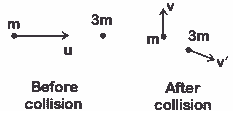The correct answer is option d) \(v={u\over \sqrt 2 }\)
Explaination ::

\(mu\hat{i}+0=mv\hat{j}+3m\hat{v'}\)
\(\hat{v'}={u\over3}\hat{i}-{v\over3}\hat{j}\)
\({1\over2}mu^2={1\over2}mv^2+{1\over2}(3m)\Big(\big({u\over3}\big)^2+\big({v\over3}\big)^2\Big)\) --------{ K.E.}
\(mu^2=m(v^2+({u^2\over 3}+{v^2\over3})\)
\(u^2=(v^2+{u^2\over 3}+{v^2\over3})\)
\(3u^2-3v^2=u^2+v^2\)
\(2u^2=4v^2\)
\(u^2=2v^2\)
\(v={u\over\sqrt2}\)